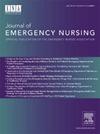TEMPORARY REMOVAL: Intentional Coingestion of RisperiDONE and Ethylene Glycol in a 35-Year-Old: A Case Review.
IF 2.3
4区 医学
Q2 EMERGENCY MEDICINE
引用次数: 0
Abstract
The publisher regrets that this article has been temporarily removed. A replacement will appear as soon as possible in which the reason for the removal of the article will be specified, or the article will be reinstated. The full Elsevier Policy on Article Withdrawal can be found at https://www.elsevier.com/about/policies-and-standards/article-withdrawal.
一个35岁的人故意摄入利培酮和乙二醇:一个病例回顾。
这是一个复杂的故意误食涉及乙二醇(一种有毒酒精)和利培酮(一种非典型抗精神病药)的病例。病人被送到急诊科时出现了反映联合毒性的无数症状。乙二醇中毒的特点是其代谢转化为有毒代谢物,可导致严重的代谢性酸中毒、肾功能衰竭和神经毒性。服用利培酮虽然不会立即危及生命,但使临床情况复杂化。利培酮是一种中枢神经系统抑制剂,可能导致乙二醇的神经紊乱。利培酮通过延长心电图反映的QT间期,有潜在的心脏并发症。这种摄入组合可导致潜在的致命性心律失常。这名患者的表现突出了诊断和管理这种过量组合的挑战,需要高度怀疑,快速识别摄入的毒素,以及积极的支持性护理。本病例回顾强调了考虑这两种摄入物质的协同作用的重要性,这可以显著改变预期的临床过程和预后。
本文章由计算机程序翻译,如有差异,请以英文原文为准。
求助全文
约1分钟内获得全文
求助全文
来源期刊
CiteScore
3.10
自引率
11.80%
发文量
132
审稿时长
46 days
期刊介绍:
The Journal of Emergency Nursing, the official journal of the Emergency Nurses Association (ENA), is committed to the dissemination of high quality, peer-reviewed manuscripts relevant to all areas of emergency nursing practice across the lifespan. Journal content includes clinical topics, integrative or systematic literature reviews, research, and practice improvement initiatives that provide emergency nurses globally with implications for translation of new knowledge into practice.
The Journal also includes focused sections such as case studies, pharmacology/toxicology, injury prevention, trauma, triage, quality and safety, pediatrics and geriatrics.
The Journal aims to mirror the goal of ENA to promote: community, governance and leadership, knowledge, quality and safety, and advocacy.

 求助内容:
求助内容: 应助结果提醒方式:
应助结果提醒方式:


